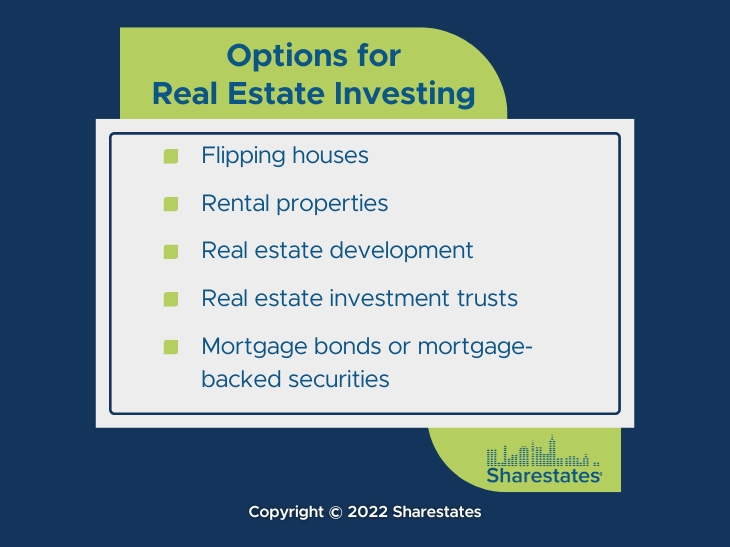In today’s turbulent investment environment, from bitcoin bubbles to gyrating stock prices, real estate investing continues to make sense. There’s a great deal of wisdom in the country song “Buy Dirt.” For all that, how do you get started in real estate, and what are the financing options? This article addresses both questions and provides steps to get started.

Options for Real Estate Investing
There are quite a few options for investing in real estate. They range from active, hands-on buying, fixing, and flipping houses to making real estate loan investments through trusts and other real estate securities. Here are a few options to consider.
- Flipping Houses. Flipping is when the borrower purchases a typically run-down or distressed property. They then invest time and effort in fixing it up before reselling it. It takes time and skill to find a suitable property, repair it, and find a buyer.
- Rental Properties. In this case, the borrower seeks a long-term return with monthly cash flow. This type of project can involve finding a property, repairing and remodeling it as needed, and then serving as a landlord. That requires finding tenants, collecting rent, and maintaining the property.
- Real Estate Development. This requires purchasing vacant land and developing it into commercial or residential property. This takes a lot of effort to find, buy, permit, build, and sell or lease.
- Real Estate Investment Trusts. Also known as REITs are companies that own and often operate properties from residential buildings to offices and even hospitals. They offer easy investment and liquidity when it comes time to sell.
- Mortgage Bonds or Mortgage-Backed Securities. Mortgage lenders pooling mortgages create these to sell to investors. These are backed by real estate as collateral. That secures the principal to avoid losses on the investment. The risk depends on the underlying mortgages and the buyers’ ability to make mortgage payments.

Options for Real Estate Financing
There are almost as many options for real estate financing as possible projects. Selecting the right real estate loan will depend on each borrower’s needs, goals, and investments. Here are the primary options.
- Conventional Bank Loans. These are typically 30-year term mortgages with minimum credit scores, maximum loan amounts, and required down payments ranging from 20 to 30 percent. They can be good options for buying and holding rental properties.
- Leveraging Your Existing Home Equity. Home equity loans or lines of credit (HELOCs) allow borrowing up to 80% of the equity in an existing home mortgage. Those funds can then be used to invest in another property.
- Hard Money Loans. Hard money lending is based on short-term high-interest rate loans secured with real estate property as collateral. Hard money loans are also known as short-term bridge loans and rehab loans.
- Private Money Loans. Private investors or lending companies provide private real estate loans. These private investors loan real estate buyers the money needed to purchase a property. They are not subject to the laws and regulations that apply to traditional banks and mortgage lenders. This allows them much more flexibility in their arrangements with borrowers.

How to Get a Real Estate Investment Loan for Your Project
Hopefully, you’ve spotted a real estate project of interest and a source for a real estate investment loan in the lists above. The next step is to obtain the financing you need to get started. Here’s a quick list of the steps to secure that loan.
- Develop a business plan. Write up your overall goals with a focus on the financial aspects. This plan can guide your efforts and demonstrate to lenders that your business and projects are sound investments. It will be a critical part of your real estate investment loan application.
- Document your previous projects. Build a summary of your previous projects to demonstrate your successful real estate project experience. The project summaries don’t have to be detailed. But photos, timelines, and financial results will help your application.
- Build a real estate network. Networks help you find others who can offer insight into available lenders. Your network should include family members, friends, and even casual acquaintances who can serve as lenders or recommend others.
- Research available lenders. You’ll need to find a lender that matches your needs since they are essentially becoming a business partner. Plus, as your business grows, you’ll want them available for other projects. Make sure your research includes reviews and ratings from others. Also, ask your network what they have experienced with a prospective lender.
- Contact the lender. After all that research, it’s time to contact the lender and start the application process. But remember that this lender could well become your partner for this real estate project and others. So evaluate their response rate, their overall approach, and if they are interested in your business. If things don’t feel right, you may need to find a different lender.
For further background, see our articles Hard Money Loans: Everything You Need to Know and Guide to Private Real Estate Loans.
We hope this brief review has helped provide insight into real estate investing and financing. Click here to learn more about funding your real estate projects through Sharestates.


